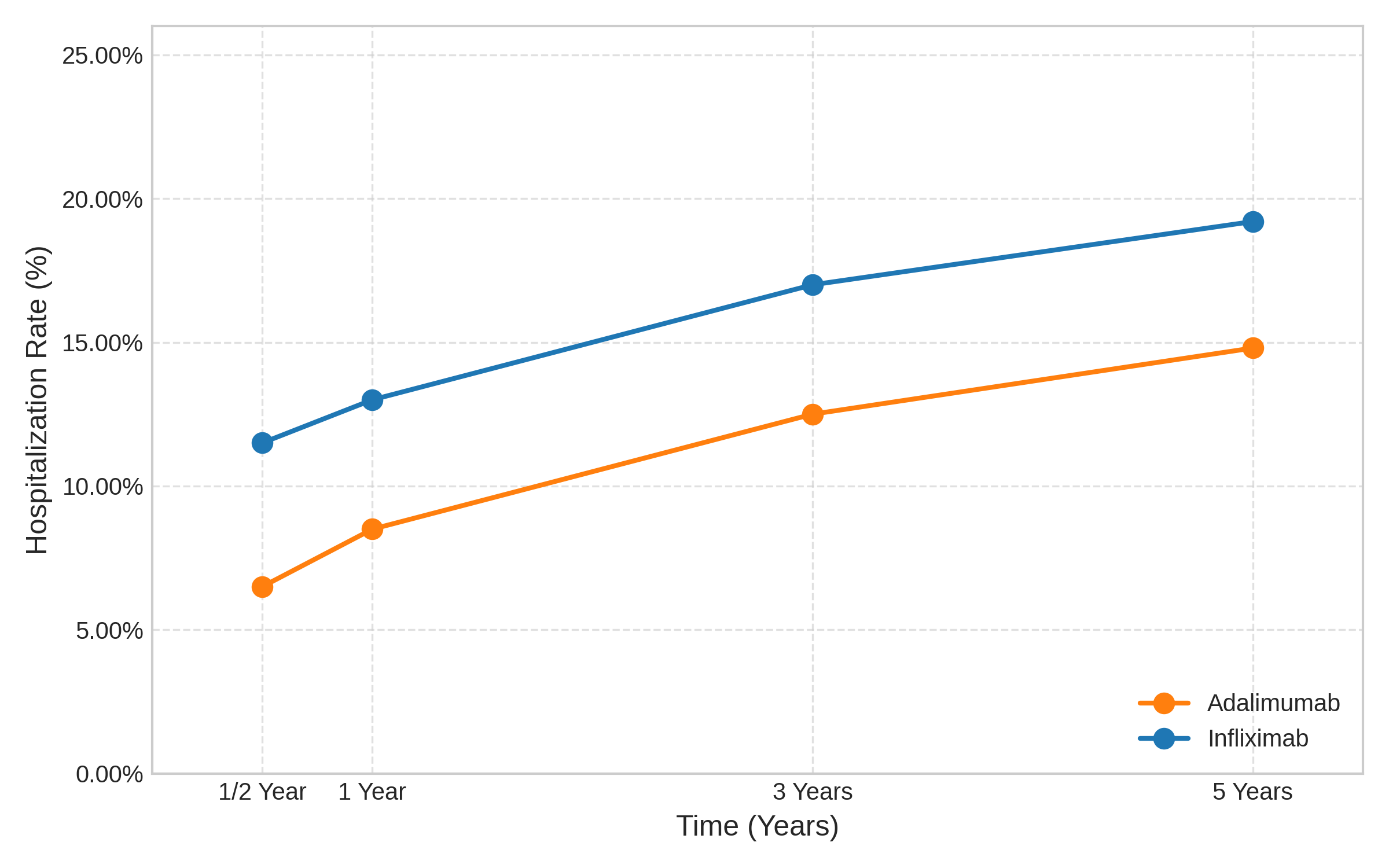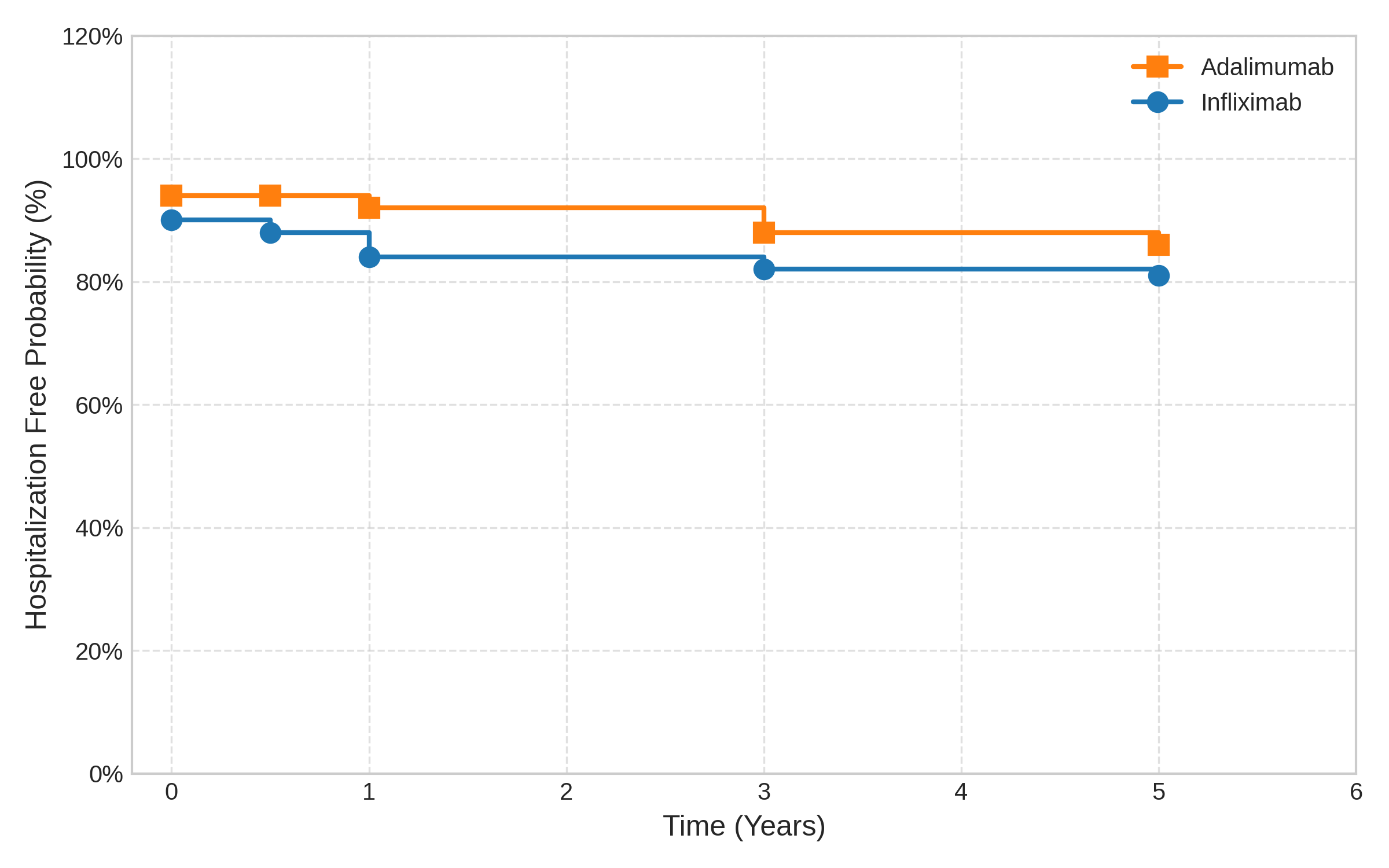Tuesday Poster Session
Category: IBD
P5340 - Adalimumab vs Infliximab: A 5-Year Real-World Comparison of Hospitalization Risks in Inflammatory Bowel Disease Patients
Tuesday, October 28, 2025
10:30 AM - 4:00 PM PDT
Location: Exhibit Hall
- OA
Osama Alshakhatreh, MD (he/him/his)
Albany Medical Center
Norfolk, VA
Presenting Author(s)
Omar Arman, MD, MPH1, Osama Alshakhatreh, MD2, Dana Khateeb, MD3, Mohammad Bushnaq, MD3, Abdulrahman Arman, MD4, Hebah Jaber, MD5, Khaled Rafeh, MD6, Mazen Zamzam, BS7, Jad Bou-Abdallah, MD1
1University at Buffalo, Buffalo, NY; 2Albany Medical Center, Albany, NY; 3University of Jordan, Amman, 'Amman, Jordan; 4University of Jordan School of Medicine, Amman, 'Amman, Jordan; 5Mutah University, Mutah, Al Karak, Jordan; 6School of Medicine, The University of Jordan, Shmeisani, 'Amman, Jordan; 7Oakland University William Beaumont School of Medicine, Royal Oak, MI
Introduction: Inflammatory bowel disease (IBD) is a chronic condition associated with frequent hospitalizations that impact patient quality of life and drive healthcare costs. Anti-TNF agents, including adalimumab and infliximab, are cornerstone therapies for IBD, but their comparative long-term effectiveness in reducing hospitalizations remains unclear. This study provides a 5-year real-world comparison of hospitalization risks between these agents.
Methods: We conducted a retrospective cohort study using the TriNetX database, including IBD patients aged ≥18 years treated with adalimumab or infliximab. Propensity score matching yielded balanced cohorts of 28,912 patients each. Hospitalization rates were assessed at 6 months, 1 year, 3 years, and 5 years. Kaplan-Meier analysis evaluated hospitalization-free survival, and hazard ratios (HRs) while risk differences, risk ratios (RR), odds ratios (OR), and hazard ratios (HR) quantified between-group differences.
Results: Adalimumab demonstrated consistently lower hospitalization rates compared to infliximab across all time points. Rates decreased from 6.61% vs. 11.62% at 6 months to 14.7% vs. 19.1% at 5 years (p< 0.001). KaplanMeier analysis showed higher hospitalization-free survival for adalimumab at 5 years (80.54%) compared to infliximab (76.19%; HR: 0.727, 95% CI: 0.699–0.757, p< 0.001).
Discussion: Our 5-year real-world analysis reveals that adalimumab reduces hospitalization risks more effectively than infliximab in IBD patients, providing actionable insights for long-term treatment strategies. Future research should explore the cost-effectiveness of adalimumab and refine treatment approaches for high-risk subgroups, including patients with comorbidities or on concurrent immunosuppressive therapies.

Figure: Figure 1: Hospitalization rates over 5 years for IBD patients treated with Adalimumab compared to Infliximab.

Figure: Figure 2: Kaplan-Meier analysis showing the probability of remaining hospitalization-free over 5 years for patients treated with Adalimumab versus Infliximab.
Disclosures:
Omar Arman indicated no relevant financial relationships.
Osama Alshakhatreh indicated no relevant financial relationships.
Dana Khateeb indicated no relevant financial relationships.
Mohammad Bushnaq indicated no relevant financial relationships.
Abdulrahman Arman indicated no relevant financial relationships.
Hebah Jaber indicated no relevant financial relationships.
Khaled Rafeh indicated no relevant financial relationships.
Mazen Zamzam indicated no relevant financial relationships.
Jad Bou-Abdallah indicated no relevant financial relationships.
Omar Arman, MD, MPH1, Osama Alshakhatreh, MD2, Dana Khateeb, MD3, Mohammad Bushnaq, MD3, Abdulrahman Arman, MD4, Hebah Jaber, MD5, Khaled Rafeh, MD6, Mazen Zamzam, BS7, Jad Bou-Abdallah, MD1. P5340 - Adalimumab vs Infliximab: A 5-Year Real-World Comparison of Hospitalization Risks in Inflammatory Bowel Disease Patients, ACG 2025 Annual Scientific Meeting Abstracts. Phoenix, AZ: American College of Gastroenterology.
1University at Buffalo, Buffalo, NY; 2Albany Medical Center, Albany, NY; 3University of Jordan, Amman, 'Amman, Jordan; 4University of Jordan School of Medicine, Amman, 'Amman, Jordan; 5Mutah University, Mutah, Al Karak, Jordan; 6School of Medicine, The University of Jordan, Shmeisani, 'Amman, Jordan; 7Oakland University William Beaumont School of Medicine, Royal Oak, MI
Introduction: Inflammatory bowel disease (IBD) is a chronic condition associated with frequent hospitalizations that impact patient quality of life and drive healthcare costs. Anti-TNF agents, including adalimumab and infliximab, are cornerstone therapies for IBD, but their comparative long-term effectiveness in reducing hospitalizations remains unclear. This study provides a 5-year real-world comparison of hospitalization risks between these agents.
Methods: We conducted a retrospective cohort study using the TriNetX database, including IBD patients aged ≥18 years treated with adalimumab or infliximab. Propensity score matching yielded balanced cohorts of 28,912 patients each. Hospitalization rates were assessed at 6 months, 1 year, 3 years, and 5 years. Kaplan-Meier analysis evaluated hospitalization-free survival, and hazard ratios (HRs) while risk differences, risk ratios (RR), odds ratios (OR), and hazard ratios (HR) quantified between-group differences.
Results: Adalimumab demonstrated consistently lower hospitalization rates compared to infliximab across all time points. Rates decreased from 6.61% vs. 11.62% at 6 months to 14.7% vs. 19.1% at 5 years (p< 0.001). KaplanMeier analysis showed higher hospitalization-free survival for adalimumab at 5 years (80.54%) compared to infliximab (76.19%; HR: 0.727, 95% CI: 0.699–0.757, p< 0.001).
Discussion: Our 5-year real-world analysis reveals that adalimumab reduces hospitalization risks more effectively than infliximab in IBD patients, providing actionable insights for long-term treatment strategies. Future research should explore the cost-effectiveness of adalimumab and refine treatment approaches for high-risk subgroups, including patients with comorbidities or on concurrent immunosuppressive therapies.

Figure: Figure 1: Hospitalization rates over 5 years for IBD patients treated with Adalimumab compared to Infliximab.

Figure: Figure 2: Kaplan-Meier analysis showing the probability of remaining hospitalization-free over 5 years for patients treated with Adalimumab versus Infliximab.
Disclosures:
Omar Arman indicated no relevant financial relationships.
Osama Alshakhatreh indicated no relevant financial relationships.
Dana Khateeb indicated no relevant financial relationships.
Mohammad Bushnaq indicated no relevant financial relationships.
Abdulrahman Arman indicated no relevant financial relationships.
Hebah Jaber indicated no relevant financial relationships.
Khaled Rafeh indicated no relevant financial relationships.
Mazen Zamzam indicated no relevant financial relationships.
Jad Bou-Abdallah indicated no relevant financial relationships.
Omar Arman, MD, MPH1, Osama Alshakhatreh, MD2, Dana Khateeb, MD3, Mohammad Bushnaq, MD3, Abdulrahman Arman, MD4, Hebah Jaber, MD5, Khaled Rafeh, MD6, Mazen Zamzam, BS7, Jad Bou-Abdallah, MD1. P5340 - Adalimumab vs Infliximab: A 5-Year Real-World Comparison of Hospitalization Risks in Inflammatory Bowel Disease Patients, ACG 2025 Annual Scientific Meeting Abstracts. Phoenix, AZ: American College of Gastroenterology.
